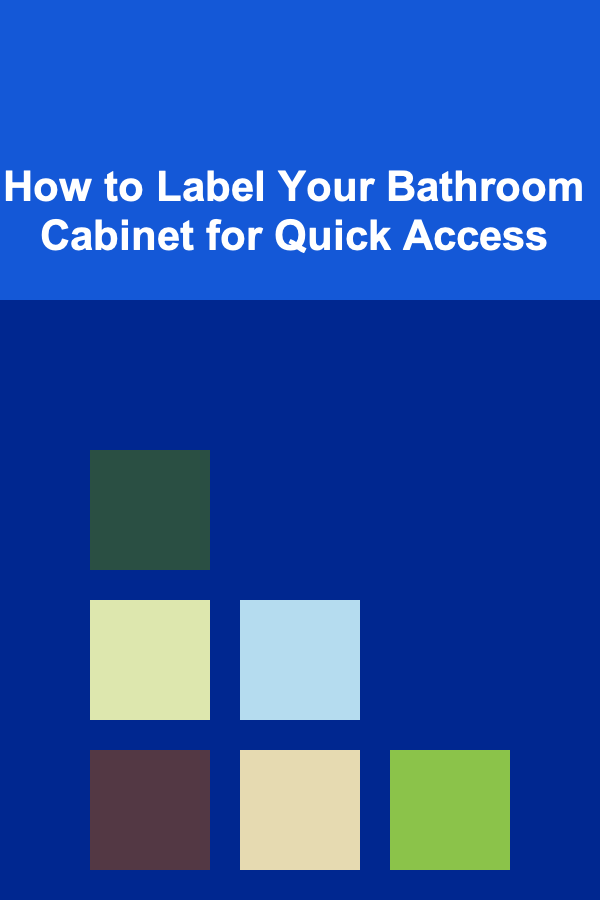
How to Label Your Bathroom Cabinet for Quick Access
ebook include PDF & Audio bundle (Micro Guide)
$12.99$10.99
Limited Time Offer! Order within the next:

In the hustle and bustle of daily life, having quick access to essential items can save time and reduce stress. This is particularly true in the bathroom, where small items can easily become cluttered and disorganized. A well-organized bathroom cabinet, equipped with effective labeling systems, can significantly enhance efficiency and ease of use. This comprehensive guide will explore how to label your bathroom cabinet for quick access, providing practical tips, methods, and creative ideas to help you maintain an organized space.
The Importance of Labeling
Enhanced Accessibility
Labeling helps you quickly identify where each item belongs, making it easier to find what you need without rummaging through drawers or cabinets.
Time-Saving
When items are clearly labeled, you spend less time searching for products, allowing for a more efficient morning routine.
Improved Organization
Labels create a systematized approach to organization, ensuring that similar items are grouped together and easy to locate.
Clarity for All Family Members
If multiple people share a bathroom, labels can provide clear instructions on where items belong, promoting cooperation and reducing clutter.
Types of Items to Label
Before diving into labeling techniques, it's essential to know which items in your bathroom cabinet should be labeled. Here are some common categories:
2.1 Toiletries
These include daily-use items like:
- Shampoo
- Conditioner
- Body wash
- Moisturizers
2.2 Cleaning Supplies
Organizing cleaning supplies ensures that you have quick access for maintaining hygiene:
- All-purpose cleaner
- Disinfectant wipes
- Glass cleaner
2.3 Medications
Labeling medications can prevent confusion, especially in households with children:
- Over-the-counter drugs
- Prescription medications
- First-aid supplies
2.4 Towels and Linens
Keeping towels organized allows for easy access when needed:
- Bath towels
- Hand towels
- Washcloths
2.5 Miscellaneous Items
This category may include items that don't fit neatly into other categories but are still essential:
- Hair tools
- Makeup products
- Nail care items
Choosing the Right Labeling Materials
Selecting appropriate materials plays a crucial role in ensuring that your labels are effective and long-lasting. Consider the following options:
Adhesive Labels
These are versatile and can stick directly to containers, shelves, or cabinets. Look for waterproof or moisture-resistant labels specifically designed for bathroom use.
Tagging Systems
Utilize tags that can be attached with string or twine, particularly for larger items or baskets.
Chalkboard Labels
Chalkboard labels are reusable and can be erased and rewritten as items change over time.
Printable Label Templates
Online templates allow you to customize labels using your computer. This option offers flexibility in design and size, ensuring that they fit your specific needs.
Labeling Techniques
Once you've chosen the right materials, consider the various techniques for creating effective labels.
4.1 Pre-Printed Labels
These ready-made labels come in various designs and sizes. They are ideal for those who want a quick solution without the hassle of customization.
4.2 Handwritten Labels
Using a permanent marker or a label maker, handwritten labels offer a personal touch and can be customized to your liking.
4.3 Color-Coding
Assign different colors to categories (e.g., blue for toiletries, green for cleaning supplies). This technique enhances visual organization and makes finding items even quicker.
4.4 Picture Labels
For families with children or individuals who may struggle with reading, picture labels can be highly effective. Use images or icons representing the item for easy identification.
Steps to Organizing and Labeling Your Bathroom Cabinet
Follow these steps to effectively organize and label your bathroom cabinet:
1. Empty Your Bathroom Cabinet
Start by removing everything from your cabinet. This step allows you to assess what you have and decide what stays and what goes.
2. Sort Items into Categories
Group similar items together to streamline the organization process. Use the categories mentioned earlier as a guideline.
3. Purge Expired or Unused Items
Dispose of expired medications, half-used products, and any items that are no longer necessary. This decluttering step will make it easier to organize what remains.
4. Choose Organizational Tools
Consider using bins, baskets, or drawer dividers to separate categories. Ensure these containers are easily accessible and visible.
5. Create Your Labels
Based on your selected materials and techniques, create labels for each category. Be as specific as possible to ensure clarity.
6. Affix Labels to Containers or Shelves
Attach the labels clearly, either on the front of the container or on the shelf where the items will be stored. Make sure labels are visible and legible.
7. Replace Items in the Cabinet
Return items to their designated places, ensuring that all storage solutions are utilized effectively.
8. Establish a Maintenance Routine
Set a schedule for regular checks on your cabinet to tidy up and update labels as necessary.
Maintaining Your Organized Space
Organizing your bathroom cabinet is not a one-time task; it requires ongoing effort to keep it tidy and functional.
Regular Check-Ups
Schedule monthly or quarterly check-ups to assess the contents of your cabinet. Reorganize and replace labels as needed.
Promptly Address Clutter
If you notice items piling up or being placed in the wrong spots, address it immediately instead of letting it accumulate.
Communicate with Others
If you share your bathroom, communicate with family members about maintaining the organization and proper placement of items after use.
Common Mistakes to Avoid
Avoid these pitfalls to ensure your labeling system remains effective:
Overcomplicating Labels
Keep labels simple and clear. Avoid using overly technical terms that anyone may not understand.
Failing to Maintain
Neglecting regular maintenance can lead to disorganization over time, defeating the purpose of labeling.
Inconsistent Labeling Styles
Maintain consistency in font, color, and size across all labels to create a cohesive look that is easier to navigate.
Ignoring Visibility
Ensure that labels are placed where they can be seen easily. If they're hidden behind items, they won't serve their purpose.
Conclusion
Labeling your bathroom cabinet for quick access is a straightforward yet impactful way to enhance organization and efficiency in your daily routines. By understanding the importance of labeling, selecting appropriate materials, and employing effective techniques, you can transform your bathroom space into a well-organized haven. With regular maintenance and attention to detail, you can ensure that your labeling system continues to work for you, saving time and reducing frustration in your everyday life. Start today, and enjoy the benefits of a beautifully organized bathroom!
Reading More From Our Other Websites
- [Survival Kit 101] The Ultimate Solar‑Powered Survival Kit for Off‑Grid Living in Desert Communities
- [Organization Tip 101] How to Create a Stylish Yet Functional Floating Shelf Display
- [Home Pet Care 101] How to Prevent Accidents and Messes from Pets Indoors
- [Organization Tip 101] How to Organize Your Running Gear for Easy Access
- [Organization Tip 101] What Are the Best Practices for Organizing Pet Supplies?
- [Personal Care Tips 101] How to Handle Stressful Situations with Calmness and Confidence
- [Home Party Planning 101] How to Organize a Smooth and Memorable Birthday Party at Home
- [Small Business 101] Best Sustainable Packaging Options for Small‑Scale Eco‑Friendly Brands
- [Organization Tip 101] How to Arrange Furniture for Family Gatherings
- [Personal Investment 101] How to Research and Invest in Impact and ESG (Environmental, Social, Governance) Funds

How to Build a Checklist for Preparing for Board Meetings
Read More
How to Choose the Best Epic Fantasies
Read More
How to Create a Functional and Beautiful Entryway on a Budget
Read More
How to Organize Pet Supplies in Your Home
Read More
Strategic Litigation Management: Insights from the Front Lines
Read More
How to Practice Contemplative Meditation
Read MoreOther Products

How to Build a Checklist for Preparing for Board Meetings
Read More
How to Choose the Best Epic Fantasies
Read More
How to Create a Functional and Beautiful Entryway on a Budget
Read More
How to Organize Pet Supplies in Your Home
Read More
Strategic Litigation Management: Insights from the Front Lines
Read More